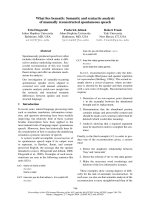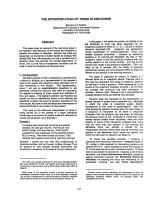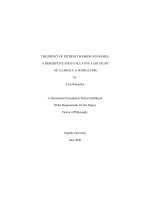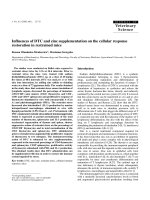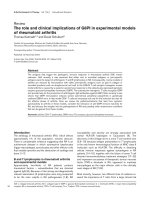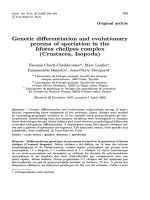- Trang chủ >>
- Thạc sĩ - Cao học >>
- Luật
Semantic and cultural interpretation of the declaration of independence in united states
Bạn đang xem bản rút gọn của tài liệu. Xem và tải ngay bản đầy đủ của tài liệu tại đây (485.17 KB, 63 trang )
MINISTRY OF EDUCATION AND TRAINING
HO CHI MINH CITY UNIVERSITY OF LAW
GRADUATION THESIS
B.A. DEGREE IN ENGLISH
Major: Legal English
SEMANTIC AND CULTURAL INTERPRETATION OF
THE DECLARATION OF INDEPENDENCE IN UNITED STATES
Supervisor: Pham Thi Thuy Dung, M.A.
Student: Nguyen Vuong Phuc Tam
Student ID: 1952202010059
Class: LE44B
Ho Chi Minh City, 2023
MINISTRY OF EDUCATION AND TRAINING
HO CHI MINH CITY UNIVERSITY OF LAW
GRADUATION THESIS
B.A. DEGREE IN ENGLISH
Major: Legal English
SEMANTIC AND CULTURAL INTERPRETATION OF
THE DECLARATION OF INDEPENDENCE IN UNITED STATES
Supervisor: Pham Thi Thuy Dung, M.A.
Student: Nguyen Vuong Phuc Tam
Student ID: 1952202010059
Class: LE44B
Ho Chi Minh City, 2023
ACKNOWLEDGEMENTS
I am writing to express my heartfelt gratitude and appreciation for the
invaluable education and experiences I have received during my time at Ho Chi Minh
City University of Law. As I prepare to move forward on my journey, I would like to
acknowledge the profound impact that this institution has had on shaping my character,
knowledge, and aspirations.
I want to start by expressing my sincere gratitude to my instructor – Mrs. Pham
Thi Thuy Dung, who have devoted her time to supporting and advising me during my
academic career. My horizons have been opened up, and a love of learning has been
fostered by her unwavering dedication to quality and her enthusiasm for teaching.
I also want to thank the administrative staffs for keeping a supportive
environment for learning and for their ongoing assistance. My educational experience
has been enriched by their commitment to planning many programs, events, and
extracurricular activities, which has also given me the chance to grow personally.
Sincerely,
Nguyen Vuong Phuc Tam
Ⅰ
ABSTRACT
This study examines the semantic and cultural interpretation of the Declaration of
Independence, with a focus on its relevance in today's world, particularly for students.
The problem addressed is the need to understand the meaning and significance of the
Declaration's concepts in contemporary society. Through an analytical analysis of the
text, key findings emerge. Firstly, semantic interpretation reveals the eloquence and
precision of the Declaration's language, emphasizing the importance of understanding
the intended meaning of its words. Secondly, cultural interpretation uncovers the social
context of the time, shedding light on the document's underlying principles. Two
research questions are designed namely (i) How do students from different cultural
backgrounds interpret the language and ideas in the Declaration of Independence?, (ii)
How does this study impact students from different cultural backgrounds'
understanding of American history and government? This is a qualitative research
using previous research results, relevant literature, theoretical basis, and the
Declaration of Independence as main research instruments. These findings provide
valuable insights into the enduring relevance of the Declaration's concepts, such as
individual rights, government accountability, and the social contract. The overall
significance of this research lies in its ability to demonstrate the timeless relevance of
the Declaration of Independence, empowering students to engage critically with its
ideas and apply them to contemporary issues. By making the research accessible and
clear, this study aims to foster a deeper understanding and appreciation of the
Declaration among students and society at large.
Keywords:
Semantic
Independence,
Interpretation,
Qualitative
Research,
Cultural
Interpretation,
Declaration
of
Analytical Analysis, Individual Rights,
Government Accountability, Social Contract Theory.
Ⅱ
TABLE OF CONTENTS
ACKNOWLEDGEMENTS........................................................................................... I
ABSTRACT................................................................................................................... II
TABLE OF CONTENTS............................................................................................ III
CHAPTER 1: INTRODUCTION................................................................................. 1
1.1 Background of the study.......................................................................................1
1.2 Aim of the study................................................................................................... 3
1.3 Research questions................................................................................................3
1.4 Significance of the study...................................................................................... 4
1.5 Scope of the study.................................................................................................5
1.6 Outline of the thesis.............................................................................................. 6
CHAPTER 2: LITERATURE REVIEW..................................................................... 8
2.1 Semantic interpretation.........................................................................................8
2.1.1 Definition of semantic interpretation........................................................... 8
2.1.2 Relevant literature........................................................................................ 9
2.2 Cultural interpretation.........................................................................................10
2.2.1 Definition of cultural interpretation........................................................... 10
2.2.2 Relevant literature...................................................................................... 10
2.3 The Social Contract Theory................................................................................ 11
2.3.1 Definition of the Social Contract Theory................................................... 11
2.3.2 Related literature........................................................................................ 12
CHAPTER 3: METHODOLOGY..............................................................................14
3.1 Analytical framework......................................................................................... 14
Ⅲ
3.1.1 Semantic analysis....................................................................................... 14
3.1.2 Cultural history...........................................................................................16
3.1.3 Critical discourse analysis..........................................................................18
3.2 Research questions..............................................................................................21
3.2.1 How do students from different cultural backgrounds interpret the
language and ideas in the Declaration of Independence?................................... 21
3.2.2 How does this study impact students from different cultural backgrounds'
understanding of American history and government?........................................ 23
3.3 Design and context of the study..........................................................................24
3.4 Research instruments.......................................................................................... 26
3.5 Data analysis procedure......................................................................................29
CHAPTER 4: RESULTS AND DISCUSSION.......................................................... 34
4.1 Analysis of data.................................................................................................. 34
4.2 Findings and discussion of results...................................................................... 36
4.2.1 How do students from different cultural backgrounds interpret the
language and ideas in the Declaration of Independence?................................... 36
4.2.2 How does this study impact students from different cultural backgrounds'
understanding of American history and government?........................................ 41
4.2.3 Diverse languages leading to various interpretations.................................46
4.2.4 Diverse cultures leading to various interpretations.................................... 49
CONCLUSION.............................................................................................................53
REFERENCES............................................................................................................. 55
Ⅲ
CHAPTER 1: INTRODUCTION
1.1 Background of the study
The Declaration of Independence is one of the most important documents in
American history, its language and meaning have been studied and discussed for
generations. Despite the huge quantity of study that has been undertaken on the
document, researchers have only lately begun to investigate the extent to which the
semantics and cultural environment of the period have impacted its interpretation.
Analyzing and discussing the strengths and limitations of prior studies' research in this
section help us approach this linguistic aspect more effectively to gain a better
understanding.
Firstly, according to Thomas (2010), the Declaration of Independence is an
essential document central to understanding the history and principles of the United
States. The title “The Declaration of Independence and Its Legacy” of the program
“U.S. History Online Textbook” may have limitations because the author does not fully
discuss the history and social conditions that led to the creation of the Declaration.
Also, the author's argument may not go deep enough into the significance of the
Declaration beyond just a symbol of American freedom. To make the title better, the
writer could do more research on the cultural and historical background of the
Declaration to have a better understanding of its original purpose and audience. Also,
he could add more information about how the Declaration's ideas are still relevant
today.
Secondly, Armitage (2004) takes a global perspective on the American
Declaration of Independence. Armitage argues that the Declaration is not just a local
document, but rather a statement of principles that had international consequences. He
analyzes the Declaration in its historical context, drawing on political philosophy,
history, and global events. The book's interdisciplinary approach helps readers
1
understand the importance of the Declaration beyond the United States. However, the
book's scholarly writing style may not be accessible to readers without a background in
history. One approach to enhance the limitations of the study would be to incorporate a
more accessible language and simplify complex ideas. This could be achieved by
utilizing examples and analogies that are relatable to the reader, rather than using
technical language that could be difficult to understand.
Finally, in "The Rhetoric of the Declaration of Independence," William (1965)
looks at how the document was written to persuade and influence people. He analyzes
different techniques and strategies used in the document, like the structure and the
specific words used by the authors. His writing is easy to understand, but some people
might think that the analysis is a bit old since it was written over 50 years ago and
might not reflect current ideas about the topic. One effective method to make the study
more approachable and understandable for writers is to break down the main points and
arguments of the text into smaller, easily digestible chunks. Another helpful approach
is to use examples and analogies to illustrate the more complex concepts presented in
the text.
Based on the strengths and limitations of the studies discussed above, an
intriguing approach to researching the Semantic and Cultural Interpretation of the
Declaration of Independence would be a qualitative content analysis of the document
itself, along with a review of historical and cultural contexts. This strategy might
include examining the political, social, and intellectual forces that influenced the
Declaration's structure as well as the language and organization of the Declaration to
identify its key themes and rhetorical devices. This study provides a deep and thorough
knowledge of the meanings and implications of the Declaration of Independence
without depending on quantitative or survey-based research procedures by utilizing a
wide range of sources and close reading techniques.
2
1.2 Aim of the study
This study promotes a national education system emphasizing liberty, individual
rights, and critical thinking. It explores the original meaning and interpretation of the
Declaration throughout American history, considering cultural and societal
developments.
Understanding the evolving concepts of liberty and equality is vital. Analyzing
individual words and phrases enhances language education, deepening students'
understanding of language nuances. Cultural interpretation examines the social and
historical context, revealing the influence of culture and history on language. Exploring
various interpretations aids in understanding the cultural and linguistic heritage of the
United States, benefiting language education and curriculum studies.
Overall, this research is crucial in teaching individuals about the importance of
liberty, individual rights, and democracy in the United States. The use of semantic and
cultural interpretation approaches can aid in developing a deeper understanding of
language and communication, as well as the cultural and linguistic heritage of the
United States. Thus, incorporating the study of the Declaration of Independence in
language education can be a valuable tool in shaping a well-rounded understanding of
American society and culture.
1.3 Research questions
This analysis helps individuals understand the significance of liberty,
democracy, and individual rights in the United States.
To foster an inclusive and diverse society, it's crucial to explore how students
from various cultural backgrounds interpret historical documents like the Declaration
of Independence. This understanding helps researchers grasp the influence of language
and ideas on different communities. The first question benefits education by enabling
educators to adapt their teaching methods to diverse student needs. Cultural awareness
3
and shared learning histories greatly shape individuals' interpretation of language and
ideas. By acknowledging these factors, educators can create an inclusive learning
environment that promotes understanding.
Students learning about American history and government benefit from
understanding the language and culture of the time. The second question expands
students' perspectives, fostering a deeper understanding of the Declaration's impact.
This study provides a thorough analysis of the document's language and values,
enhancing students' comprehension of its historical context and societal influence.
Moreover, it cultivates critical thinking skills as students analyze the text and interpret
its meaning through this research.
In conclusion, understanding how students from different cultural backgrounds
interpret the Declaration of Independence is crucial to building a more inclusive and
well-rounded understanding of American history and government.
1.4 Significance of the study
This study offers a fresh perspective on the Declaration of Independence by
using additional relevant documents to demonstrate its contemporary relevance. By
employing plain language, the research aims to enhance accessibility and engage a
wide range of readers, particularly students learning legal English. Through this
approach, the study contributes to a better understanding of the principles embedded in
the Declaration and their impact on American society.
To ensure comprehensibility, this study employs qualitative research methods to
analyze the linguistic aspect of the Declaration of Independence. It considers cultural,
historical, and social factors influencing language use, examining specific words,
phrases, and discourse patterns. By doing so, the study uncovers a deeper
understanding of the document's meaning, significance, and underlying themes. It
explores the broader implications for American society and culture, shedding light on
4
the Declaration's role in shaping American identity and values. Utilizing qualitative
research methods and plain language enhances accessibility and engagement for
students, contributing to a better understanding of the Declaration's principles.
Qualitative research methods and plain language foster critical thinking, deepening
students' understanding of American history and society. Examining the linguistic
aspect of the Declaration of Independence promotes a nuanced comprehension of
embedded values and principles. This equips students to engage with complex ideas,
think critically, and recognize how language shapes perceptions. The study contributes
to civic education, encouraging students to connect historical ideas to their lives today.
By exploring the Declaration and related documents, educators cultivate civic
responsibility and engagement among students.
1.5 Scope of the study
The scope of this study is vast and multifaceted. All three aspects will be studied
in an orderly, which means the first two aspects regarding the semantic interpretation
and cultural interpretation will be conducted textually while the aspect regarding the
Social Contract Theory will be analyzed socially.
In the first aspect of the study, semantic interpretation involves analyzing the
meaning of words and phrases used in the text. In this case, it would involve examining
the language used in the Declaration of Independence and understanding the intended
meanings of the words and phrases used by the authors. For example, the phrase "all
men are created equal" can be interpreted in various ways, and semantic interpretation
would involve understanding the nuances of its meaning in the context of the
document.
Cultural interpretation, on the other hand, focuses on the historical and cultural
context in which the text was produced. In the study of the Declaration of
Independence, cultural interpretation would involve understanding the political and
5
social factors that led to its drafting, such as the growing discontent among the
American colonists towards British rule. Cultural interpretation also involves
understanding how the values and beliefs of the time shaped the ideas expressed in the
document. For example, the concept of "unalienable rights" expressed in the
Declaration reflects the Enlightenment ideals of individual liberty and equality, which
were prevalent in 18th-century America.
Finally, the third aspect of the study will examine the concept of the Social
Contract theory in the Declaration of Independence. This will involve examining how
the document reflects the concept of natural rights and the need for the people’s
consent to form a civil state. To analyze this aspect, one can examine how the
Declaration of Independence reflects the concept of natural rights and the need for the
people’s consent to form a civil state. For example, the document states that all men are
created equal and endowed by their Creator with certain unalienable Rights, among
these are Life, Liberty, and the pursuit of Happiness. This reflects the concept of
natural rights, which holds that individuals have certain inherent rights that cannot be
taken away by any government or authority. Understanding the Social Contract theory
is key to fully grasp the meaning and implications of the Declaration of Independence.
1.6 Outline of the thesis
Chapter 1 introduces the research study, highlighting its background, strengths
and limitations of previous studies, research questions, and significance. It defines the
study's scope, focusing on semantic and cultural interpretation.
Chapter 2 presents a literature review on semantic interpretation, cultural
interpretation, Social Contract theory, and a conceptual framework. It establishes
definitions, explores historical significance, and integrates the key concepts.
6
Chapter 3 outlines the methodology, addressing research questions, study
design, and qualitative research instruments. It describes data analysis procedures,
excluding interviews and questionnaires.
Chapter 4 analyzes the data, discussing results, implications, limitations, and
suggestions for further study. It offers insights based on the researcher's expertise and
contributes to the overall thesis.
7
CHAPTER 2: LITERATURE REVIEW
2.1 Semantic interpretation
2.1.1 Definition of semantic interpretation
Semantic interpretation is the process of understanding natural language text or
speech in terms of its meaning. It involves extracting the underlying information from
a sentence or utterance and representing it in a structured format that can be used for
further processing.
The first step in semantic interpretation is to identify the words and phrases in
the input text. This is known as parsing, and it involves breaking the text down into its
constituent parts and identifying the relationships between them. For example, a parser
might identify a noun phrase like "the red ball" and recognize that "red" is modifying
"ball". Once the text has been parsed, the next step is to assign meaning to each word
and phrase.
Semantic interpretation often involves disambiguation, since many words have
multiple possible meanings depending on the context in which they are used. For
example, the word "bank" could refer to a financial institution or the side of a river. In
order to determine which sense of the word is intended, a semantic interpretation
system needs to look at the surrounding words and the overall context of the sentence.
There are many different approaches to semantic interpretation, and different
systems may use different techniques depending on their specific requirements. Some
systems use rule-based approaches, where a set of predefined rules is applied to the
input text to extract its meaning. Other systems use statistical methods, where large
amounts of data are analyzed to identify patterns and relationships between words and
concepts.
8
2.1.2 Relevant literature
In the study titled "Semantic Interpretation and the Resolution of Ambiguity"
conducted by Graeme Hirst, the concept of semantic interpretation is defined as the
process of mapping a syntactically analyzed text of natural language to a representation
of its meaning (Hirst, 2009). The researcher clarifies that a parse tree serves as the
input for a semantic interpreter, and it is not necessary for the parse tree to represent a
complete sentence. Well-formed subtrees, such as noun phrases or single words labeled
with their syntactic category and features, can also be utilized as input. The primary
output of a semantic interpreter is the literal meaning of the input text or an appropriate
representation of it (Hirst, 2009).
In "Transformational Syntax and Model Theoretic Semantics: A Case Study in
Modern Irish," James McCloskey discusses the interpretation of a language within the
framework of Montague's general theory (McCloskey, 2012). According to Montague's
theory, the interpretation of a language L involves three components: interpretations for
each lexical item of L, interpretation rules corresponding to the syntactic rules of L,
and interpretations for the well-formed expressions of L, defined recursively by the
combination of the previous components (McCloskey, 2012).
When the interpretation is carried out through translation into intensional logic,
as is the case in this study, the first component (1) comprises a function that maps
lexical items of L to meaningful expressions of intensional logic, whether they are
basic or derived expressions. The second component (2) consists of a set of operations,
each associated with a syntactic rule of L, which associate a translation, an expression
of intensional logic, with each complex expression of L. This translation is determined
by the translations of the constituent parts of the complex expression and the specific
syntactic rule that combines those parts (McCloskey, 2012).
9
2.2 Cultural interpretation
2.2.1 Definition of cultural interpretation
Cultural interpretation is the process of understanding and analyzing various
cultural aspects such as beliefs, values, norms, and practices of a particular society or
group. It involves exploring the meaning behind symbols, traditions, and customs to
gain a deeper understanding of the culture and its people. Cultural interpretation is
essential in promoting cross-cultural communication, understanding, and appreciation.
Cultural interpretation is also known as the analysis and presentation of cultural
representations or meanings to different groups of people. It involves understanding
how people make sense of themselves and their world, and how cultural differences
influence social interactions. It also requires personal experience and competence in
both the cultures of the resource and target languages. Cultural interpretation can be
seen as a way of “reading” culture as text, with attention to the organization of social
activity, its institutional forms, and the system of ideas that animate it.
In today's globalized world, cultural interpretation has become increasingly
important as people from different cultures come into contact with each other. It helps
to bridge the gap between cultures and promotes respect and tolerance. Cultural
interpretation is used in various fields, including tourism, education, international
business, and diplomacy.
Cultural interpretation is a complex and multifaceted process that involves
examining cultural phenomena through various methods of interpretation, including
thick description. It is important for gaining a deeper understanding of cultural
diversity and its impact on various aspects of society.
2.2.2 Relevant literature
According to Simbirtseva (2020), interpretation holds a significant position in
the methodology of the humanities. It serves as a method of scientific knowledge
10
aimed at comprehending the internal essence of the object being interpreted through the
examination of its external manifestations, such as signs, symbols, artifacts, acts, and
images. Through interpretation, the cultural context's meanings, values, and their
significance in the present are revealed.
In educational practices, cultural interpretation plays a crucial role as it directly
impacts the quality of the dialogue established between teachers and students. The
teacher's knowledge of the foundations, methods, and the developmental mechanisms
and laws of culture allows for a meaningful exchange. A proficient specialist in
cultural interpretation possesses a well-rounded background, encompassing historical
knowledge and the ability to establish a connection between the past and the present
(Simbirtseva, 2020).
Carbaugh (2009) defines cultural interpretation as an investigative mode that
aims to establish coherence and intelligibility in participants' communication practices.
This is achieved through the explication of a system of symbols, symbolic forms, and
meanings that are creatively evoked within those practices. The objective of cultural
interpretation is to unravel the intricate connections between communication and
culture (Carbaugh, 2009).
2.3 The Social Contract Theory
2.3.1 Definition of the Social Contract Theory
The Social Contract theory is a political philosophy that suggests that
individuals give up some of their individual freedoms in exchange for protection and
support from the government. The theory suggests that individuals agree to give up
some of their freedoms in order to live in a society that is governed by laws and
regulations. The idea behind the Social Contract theory is that individuals agree to live
under the authority of the government in exchange for protection and support. The
theory grew to prominence as the leading doctrine of political legitimacy during the
11
mid-17th to early 19th centuries. According to the Internet Encyclopedia of
Philosophy, "Social contract theory, nearly as old as philosophy itself, is the view that
persons’ moral and/or political obligations are dependent upon a contract or agreement
among them to form the society in which they live".
The Declaration of Independence is an example of Social Contract theory in
action. It states that governments derive their power from the consent of the governed
and that it is the right of the people to alter or abolish any government that does not
serve their interests.
Other examples of Social Contract theory include the works of Thomas Hobbes,
John Locke, and Jean-Jacques Rousseau. Hobbes believed that people were naturally
selfish and violent and that a strong government was necessary to keep them in check.
Locke believed that people were naturally good and that they had certain natural rights
that the government should protect. Rousseau believed that people were naturally good
but that society corrupted them.
2.3.2 Related literature
Hobbes's seminal work, "Leviathan," published in 1651, is a significant
contribution to social contract theory (Hobbes, 2019). Building upon his earlier work,
"De Cive" (1642), it delves into the structure of society and the concept of legitimate
government. The book argues that humans are inherently in a state of conflict and
highlights the necessity of a social contract to transcend this state of war. According to
Hobbes, the social contract entails an agreement between individuals and the
government, where certain rights are relinquished in exchange for protection. The
government, symbolized as the Leviathan, is depicted as all-powerful, possessing
complete control to maintain order and prevent chaos.
John Locke's "Two Treatises of Government" is a seminal work in social
contract theory and modern political theory. The book challenges the divine right of
12
kings and defends the people's right to depose tyrannical rulers. It emphasizes that
political power comes from the consent of the governed and highlights natural rights
such as life, liberty, and property. Locke's ideas on natural rights and the role of
government have had a profound impact on modern political theory (Locke, 1988).
Rousseau's "The Social Contract" (1762) explores the challenges of forming a
political community in commercial society. The book presents a theory of government
based on a social contract where individuals surrender their natural rights for
protection. Rousseau emphasizes popular sovereignty, citizen oversight, and proposes a
tribunate for emergencies. He advocates for a single, tolerant religion to foster unity
while respecting individual beliefs (Rousseau, 1762).
13
CHAPTER 3: METHODOLOGY
The purpose of this study is to thoroughly understand the importance of the
Declaration of Independence for the world through its semantic and cultural
interpretation on numerous online platforms. At this stage in the research, the
methodology employed in this study includes research questions, design and context,
research instruments, and data analysis procedure.
The first part answers two relevant questions to show the practical applicability
of this study to other fields, especially to education. The design and context of the
study include a qualitative research approach through an in-depth examination of
historical and cultural contexts surrounding the document's creation and reception.
Research instruments include primary sources such as historical records, speeches, and
letters, as well as secondary sources like scholarly articles and books. Finally, the
analysis procedure explains how the conceptual framework is formed and illustrates
this process step by step to show the results.
The methodology mentioned in this chapter provides an important foundation
for understanding the approach taken in the research of the Declaration of
Independence.
3.1 Analytical framework
A possible analytical framework for this study could be based on three main
components: semantic analysis, cultural history, and critical discourse analysis.
3.1.1 Semantic analysis
Semantic analysis would involve examining the meaning of the language used
in the Declaration of Independence at a micro and macro level, focusing on the
meanings of individual words and phrases, as well as their relationship to one another
within the document.
14
Graeme Hirst's study titled "Semantic Interpretation and the Resolution of
Ambiguity" is a well-written volume that focuses on providing a theoretically
motivated foundation for semantic interpretation, also known as conceptual analysis, in
the context of natural language processing. Hirst's research interests cover a range of
topics in computational linguistics, including lexical semantics, the resolution of
ambiguity in text, and the analysis of authors' styles. In his study, he concentrates on
the challenges and techniques involved in resolving ambiguity in natural language
processing, which is a critical aspect of understanding and interpreting human language
effectively. It's evident that the primary component used in Hirst's study is semantic
analysis. The focus on resolving ambiguity in natural language processing highlights
the importance of semantic interpretation in understanding the meaning and intent
behind human language.
Although it is not possible to find a direct link between Graeme Hirst's method
and this study, based on the information provided in the online search results, the
researcher still can extrapolate some general ideas about how Hirst's method could be
applied to the research.
The search result mentioning "Applying a procedure to an unfamiliar task"
suggests that Hirst's method could be adapted and applied to the analysis of the
Declaration of Independence, even if it was not originally designed for that purpose.
By using Hirst's approach to resolve ambiguities in natural language processing, the
researcher can potentially uncover new insights into the intended meaning and cultural
significance of the document.
The search result about "a situational analysis of the semantics of can" suggests
that Hirst's method could be applied to the study of specific words and phrases in the
Declaration of Independence. This could help us better understand the nuances of the
language used in the document, as well as the possible ambiguities and multiple
meanings that could arise from its interpretation.
15
The search result discussing "collective remembering and outlines dynamics
between communicative and cultural" emphasizes the importance of understanding the
relationship between language, culture, and collective memory. By applying Hirst's
method to the study of the Declaration of Independence, the researcher can analyze
how the language used in the document reflects the cultural values and beliefs of the
time, as well as the ways in which these values and beliefs have been remembered and
transmitted through generations.
3.1.2 Cultural history
Cultural history would provide a broader context for understanding the
Declaration of Independence, situating it within the social, political, and cultural
currents of 18th-century America. This component would draw upon cultural studies
and historical methods to explore the ways in which the document was influenced by
factors such as Enlightenment philosophy, colonial politics, and revolutionary rhetoric.
In the study "Cultural Interpretation: From Method to Methodology",
Simbirtseva N.A. focuses primarily on the component of cultural history. The study
aims to establish a theoretical and methodological framework for understanding
cultural interpretation. It emphasizes the importance of cultural context in interpreting
any work, including texts, and outlines various methods and approaches to
comprehensively understand culture in the interpretation process.
Applying Simbirtseva's method to the study of the Declaration of Independence
would involve considering the cultural context in which the document was created.
This would include examining the political, social, and economic factors that
influenced its creation, as well as the beliefs and values of the authors and their
audience. This approach would help us understand the intended meaning and
significance of the Declaration of Independence within the broader cultural context of
the time.
16
The researcher would also need to consider Simbirtseva's method of using
cultural history as a methodological approach to interpreting and analyzing cultural
artifacts that can be applied to the study of semantic and cultural interpretation of the
Declaration of Independence in several ways.
Firstly, by using cultural history, the researcher can gain a deeper understanding
of the historical and cultural context in which the Declaration of Independence was
written. This includes understanding the political, social, and economic conditions that
existed in the United States at the time, as well as the intellectual and philosophical
currents that were influential in shaping the document. Secondly, by considering the
ways in which the Declaration of Independence has been interpreted and reinterpreted
over time, the researcher can gain insight into its evolving cultural significance.
For example, the researcher might analyze how different groups or individuals
have interpreted the document differently based on their cultural background, historic
events, and personal beliefs. Thirdly, Simbirtseva's emphasis on the importance of
considering the ways in which cultural artifacts are received and interpreted by
different audiences is particularly relevant in the case of the Declaration of
Independence. As a foundational document of American democracy, the Declaration
has been interpreted and appropriated by different groups throughout history, each with
its own cultural and political agendas.
Simbirtseva's method of cultural history provides a valuable approach to
understanding the Semantic and Cultural Interpretation of the Declaration of
(Fairclough, 2010)Independence. By considering the historical and cultural context in
which the document was created and how it has been received and interpreted over
time, the researcher can gain a richer and more nuanced understanding of its meanings
and significance.
17
3.1.3 Critical discourse analysis
In this section, the critical discourse analysis method, as developed by Norman
Fairclough in his work "Critical Discourse Analysis," is employed to examine the
language and discourse used in the Declaration of Independence and its cultural
implications.
Drawing on Fairclough's framework, the study recognizes that language is not a
neutral tool for communication but a site of power struggles, shaping and reinforcing
social structures and ideologies. By adopting a critical discourse analysis approach, the
researchers aim to uncover hidden meanings, power relations, and ideological
underpinnings within the text of the Declaration of Independence.
The analysis begins with a textual analysis, focusing on the linguistic features
and structures within the document. This involves scrutinizing the choice of words,
rhetorical devices, and syntactic patterns to reveal the intended meanings and the
discursive strategies employed. Through this analysis, the researchers aim to identify
how language is used to convey and legitimize certain ideas and values while
marginalizing others.
Moving beyond the textual level, the study incorporates discursive practice
analysis to examine the broader social contexts in which the Declaration of
Independence was produced and circulated. This involves considering the historical,
cultural, and political factors that influenced the language and discourse used in the
document. By situating the text within its socio-cultural framework, the researchers
aim to elucidate how the Declaration reflects and reinforces the prevailing power
structures and dominant ideologies of the time.
Additionally, the study employs social practice analysis, exploring the social
implications and effects of the Declaration of Independence. This involves examining
how the language and discourse used in the document have been interpreted,
18
appropriated, and contested over time. By analyzing the ways in which the Declaration
has been invoked, debated, and reconstructed within different historical and cultural
contexts, the researcher aim to understand its enduring significance and its role in
shaping collective memory and cultural identity.
Through the application of the critical discourse analysis method within the
study's analytical framework, the researcher aim to uncover the semantic and cultural
dimensions of the Declaration of Independence, shedding light on the complex
interplay between language, power, and ideology embedded within this influential
historical document.
19



